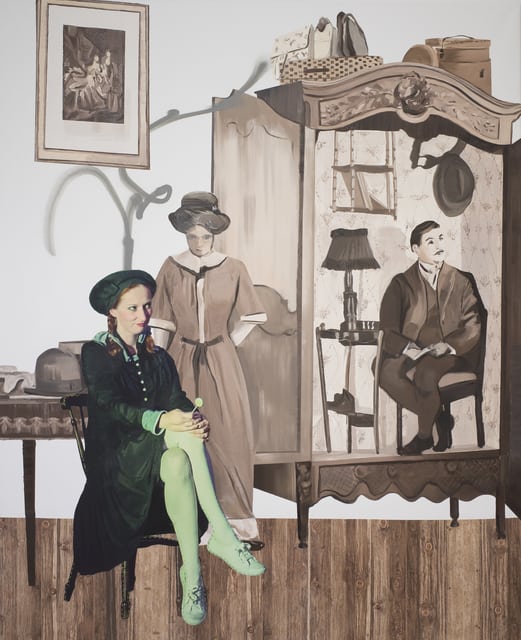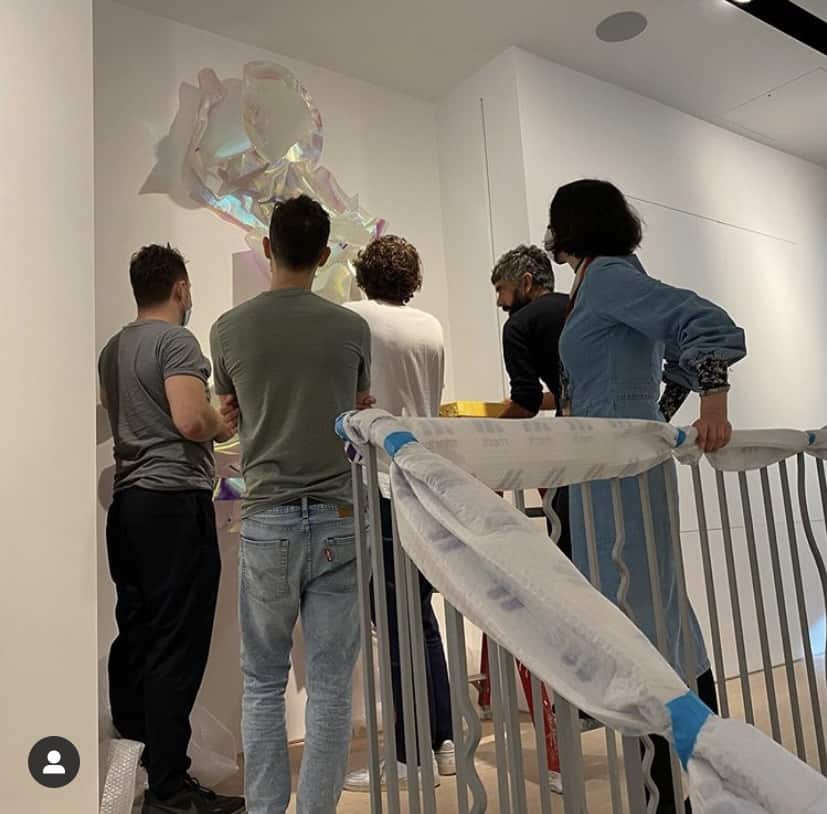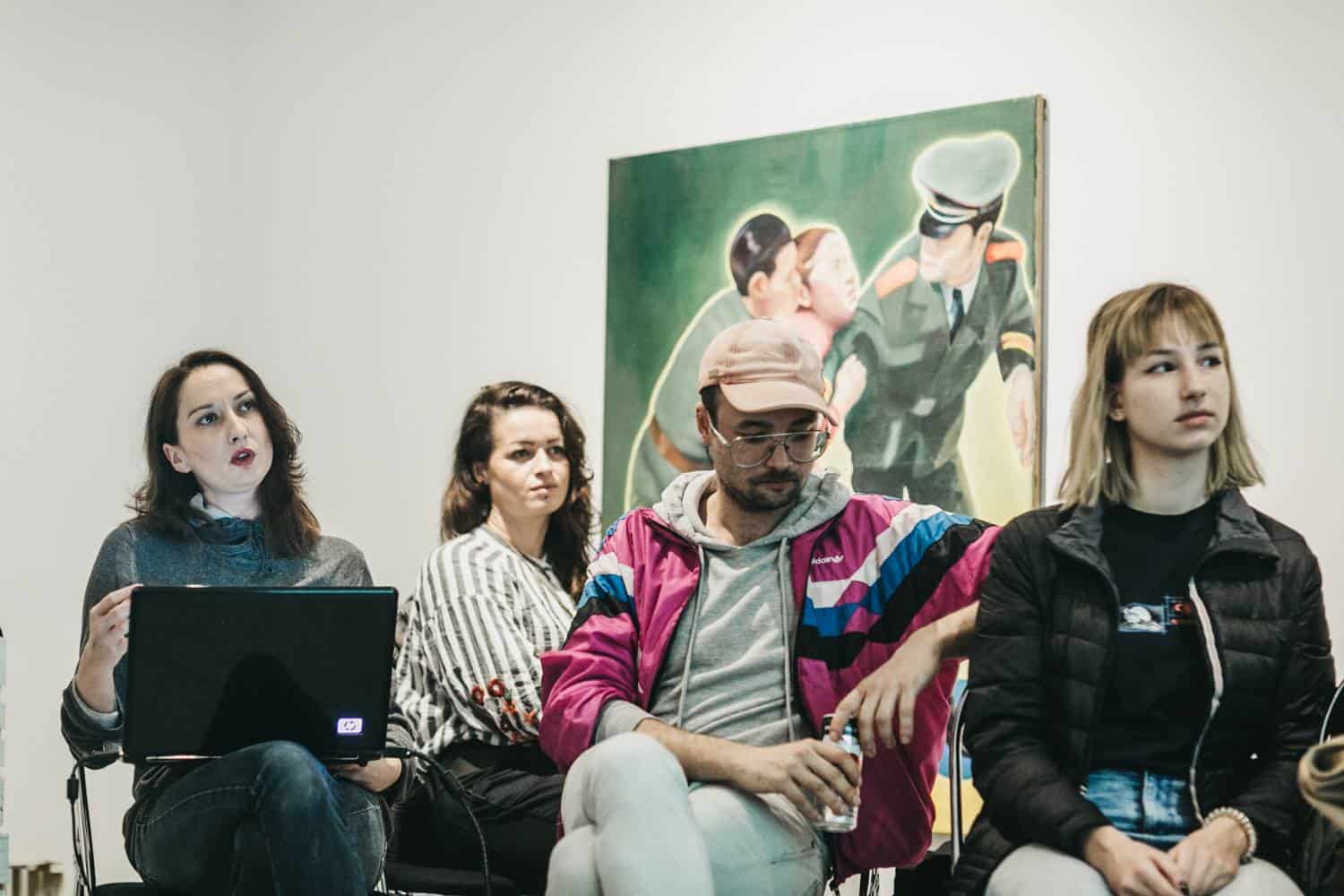No matter where you live, finding a job after a humanities degree is not easy; harder still, to say what makes a perfect job. In this series of interviews, we ask art professionals about their careers after graduation.
Here, we speak to Kola Śliwińska from London. Kola is an independent curator, collection manager and writer. Since 2012 she has been researching Wladyslaw Hasior’s practice, and she is currently working on his monograph. She has collaborated with a number of institutions, inter alia: Polish Cultural Institute, Fiorucci Art, Tate Modern; currently she works for Valeria Napoleone’s collection in London. She is interested in social and community situations as well as looking for non-institutional forms of ‘being together’ in the face of social and ecological crises. She believes she is one of many witches. If she could, she would spend the whole year in nature, and she would like not to have to fight for women’s fundamental rights in the future.
She discusses chance encounters, biographical detective work, a risky move to London and the formative influences of others; she stresses the importance of collaboration and free thought.
KOLA ŚLIWIŃSKA
Position: Collections manager and independent curator
Location: London
Could you describe your current position?
Kola Śliwińska: I’m working in London in the collection of Valeria Napoleone, who is a private art collector focusing exclusively on female artists. She is also a global philanthropist, and she has funded the platform Valeria Napoleone XX which collaborates closely with the Contemporary Art Society in London, and in New York Sculpture Center and the Institute of Fine Arts (NYU). Through this platform, she supports female artists and their practices. In my own professional practice, it is almost a new starting point which would not have happened without the great support of so many wonderful people like Paulina Latham (Polish Cultural Institute) who guided and mentored me for so many years and Joanna Gemes (l’étrangère gallery) who recommended me for the position.
I am responsible for the collection not only in a curatorial capacity, but also in arranging shipments and loans to institutions worldwide; so I act as a registrar, assistant, researcher, and also event manager, as we host up to fifteen events each year. They are mostly dedicated to artists, exhibitions, or initiatives related to female practices; usually, they are accompanied by talks with artists. For me, the moment when I met Judith Bernstein in person was absolutely special. She has always been my heroine: part of the anti-war and feminist movement from the 1960s and 1970s, she was a cult figure in the arts outside the mainstream agenda. I learned about her practice from books! And there she was, standing in the door at Valeria’s house. I was speechless — it took me a few moments to finally talk to her, and it was an unforgettable experience. She happened to be ten thousand times more interesting than any book or article that had been written about her or her practice (laugh). She is a volcano of energy and a stream of wisdom.
Working closely with Valeria Napoleone taught me how to be authentic and bold in choices that I make but also (what is even more important) not to be afraid of telling the truth, because this is the quality that conducts our practices. To break stereotypes and work with people as at the end the community is the most important factor that shapes our lives.
At the same time, I am an independent curator working with many institutions. I have created a few projects which are meaningful to me in close collaboration with the artist Ewa Ciepielewska, who is also my dearest friend. Our project Flow [Przypływ] (2016), which was distinctive for taking place on a boat on the Vistula river, continues in the form of a yearly residential programme for artists. It is very experimental — we used the space of the boat to create a special context for artists. They are there to find their own role, analogical to the La Borde Clinic lead by Guattari and Deleuze in the 1980s where patients became therapists and therapists patients. One of the patients created a theatre where another catatonic patient was supposed to have started talking, singing, using sentences again. When asked why he was doing it, he replied: ‘Because it is not happening for real.’ And I think because we are on the boat and the water has its own changeable quality, flowing quality I may say, it is also not happening for real. We are completely outside the mainstream agenda and institutional circuit. Moreover, it is special because of its horizontal assumptions where no one is in charge and everyone is equal. There is no need to do anything, and every single individual after few days finds his/her/their place on the boat.
There is another aspect to practice which I really enjoy. Since 2016, I have been working on Władysław Hasior’s biography with Ania Batko, a fantastic art critic and curator. This is my biggest initiative so far, and it has proved a challenging experience on account of the difficulties of biographical research. Writing about someone’s life is the most difficult task I have ever undertaken in my life. It took us a couple of years to complete the archives, get through artist’s personal correspondence and find people (as well as his previous girlfriends) who want to talk about private or intimate relationships with him. It’s like playing hide and seek or being a detective tracing the evidence. Sometimes we both feel like Colombo; we try to play it around. But sometimes we don’t have enough evidence and have to give up on some aspects of his life which are important to build threedimensional character.

Voodoo Africa, 2015, Razem Pamoja Ksiegarnia Wystawa, Kraków, with Luxus group
How did you begin your career?
KŚ: My background is in linguistics, but after university and a few scholarships abroad I decided to try working in the arts, as I felt it might be a great experience for me. I had no clue what I wanted to do in my life. I was completely lost. And then, in 2012, I met Ewa Ciepielewska, the artist from the former Luxus group in Poland. It was clearly a strong sign that my life was now leading me somewhere. Ewa is an amazing personality and has this special aura that shines somewhere in the air around her. I just had a feeling that with her I could break through to the other side and explore worlds that I could never have explored in normal life. Here, art was an alive activity, not a dead experience enclosed within the walls of an institution: Ewa is a free spirit who would go mental in such a context. She became my very first guide in the art world, my University of Art.
Ewa and I started to work on Hasior, whose oeuvre had been completely forsaken by the Polish art milieu due to his controversial political engagement in the communist era. I was of the opinion that art is beyond politics and that his practice should be brought to the attention of curators and art critics. I wanted to start a revolution in the critical reception of this artist. I wanted him to symbolise the need to settle accounts with our dramatic and complex past.
I moved to London in 2013. At the very beginning, I met Paulina Olowska who invited me almost instantly to work on her new project with the Fiorucci Art Trust, Mycorial Theatre. The very first edition was conducted in 2014. In the same year, along with Kasia Redzisz (Senior Curator at Tate Liverpool), I organized the Tatra Conference dedicated to Władysław Hasior. We invited an international group of scholars and curators to consider the artist’s oeuvre in a wider context. At this point, my career turned instantly. Its course eventually lead to institutions, first the Polish Cultural Institute where I lead the Cultural Heritage Department, then the commercial l’ètrangère gallery in East London.

Performance at Tate Modern, BMW TATE LIVE: PAULINA OLOWSKA: ‘THE MOTHER AN
UNSAVOURY PLAY IN TWO ACTS AND AN EPILOGUE’ 2015, photo by Hydar Dewachi
How long have you prepared for this job?
KS: I feel that I have been preparing for this all my life. When I was performing at Tate Modern for Paulina Olowska, a sense of purpose hit me for the very first time. After the second or third performance in front of a strange crowd of people, I felt almost addicted to the adrenaline in my veins. It is the same with managing and curating. It is like dealing with invisible energy; it gives you strength, flow but it can also give you a heart attack or stroke if something goes wrong.
What skills help a collections manager?
KŚ: It’s almost impossible to speak about your skills openly. Apart from job interviews, it does not happen often with me; I find it really uncomfortable and phoney. But let’s say challenge accepted, though you should know I had to ask a few people for the answers. Apparently, I have always been able to compose objects in space. The spatiality of exhibitions is something that I understand and like to work on. I also spot talents in people; therefore, I help young artists who I find talented to develop their careers. Finally, I have good relationships with artists, and this helps when working on projects.
What is the riskiest decision you have taken?
KŚ: I think when I decided to move to London. Apart from a few friends, I was on my own in this city. In the first year I was attacked, had the flu of a lifetime, and dealt with bedbugs. It was pretty traumatic. With no connections, I started building my own reality which was like entering a huge ocean without knowing how to swim. When I think of that period in my life, I am not sure that I would take the risk again. But I am glad I did it. I can finally say that I achieved something, a kind of stability.
What is the most difficult task you have undertaken?
KŚ: The most challenging task has been recently to move Valeria Napoleone’s collection to a new place in London. It took us three weeks to manage this, months of preparations, and the world’s best team of technicians: Marco Pagliardi, Liam Tickner, and Giovanni Fazzolari. I could have never done it without them. They had to deal not only with the artworks, but also with stressful situations. As what you might call the ‘invisible hand’ of the art world, technicians are often extremely creative people with their own practices — but I think this is material for another interview. In the collection, we really appreciated their work and commitment. The atmosphere was fantastic, we had a lot of fun working together. So again, team and people are crucial to achieving the best results.

Paulina Olowska Zofia Stonybroke, 2016 Collage with embroidery, oil, gouache and enamel on
canvas 220 x 180 cm (86 5/8 x 70 7/8 in.) Courtesy of the artist and Simon Lee Gallery
What is your biggest failure?
KŚ: It was a few years ago. I organized a symposium about a Polish art group from the 1980s; I invited a few curators and academics from the UK. Unfortunately, due to miscommunication and my stubbornness, I proceeded with the project even though the artists were not fully interested. I guess that was my biggest lesson and a great failure.
What is your biggest success?
KŚ: It is November 2020 and as a real hypochondriac I may proudly say that I have not contracted Covid-19 so far — this is pretty successful. But seriously, I think I am at the bottom of my Mount Everest. With the exception of the community I have built, I think everything is just ahead of me. Time will tell where I go with my practice, as all is constantly moving.
What three tips would you give someone wishing to work in the art world?
KŚ: The first tip: be authentic
The second: always be surprised with what you experience and look at things as if for the very first time in your life. This gives you a fresh start with everything, almost child-like playfulness. To me, it is crucial.
The third tip would go like this: work with people and build your own community. Multiple configurations are always more interesting. I love working as a team where everyone is equal and there is this horizontal perspective, instead of the vertical pyramid of the feudal system that we are actually living in: this illusion that there is a solid structure that protects us, but in fact it is a system of mendacity. In the era of fake news, stay put and think about your own community. Talk more to the trees, fish, birds, and all the nature that surrounds you.
I did a project with Ania Batko and Ewa Ciepielewska; what we wrote in our manifesto back then can be my conclusion here. We created a body balm with roses that changes the way we perceive the world:
We have the sticky structure of a cream, the intimate ritual of massaging it into the skin, and then we have the scent, sweet and cloying, suffocating and sensual, full of contradictions. We will eat, taste and massage. Because we smear ourselves only with what we want to eat. Something that remains and is detectable before it appears. Something that needs no language, because rose is a rose is a rose. A tangle of emotions, a story that sweeps up fragments of other stories, expressed or concealed, which itself becomes part of someone’s story.
If not collections manager, what would be your dream job?
KŚ: Comedian, I always wanted to be a stand-up comedian. I guess I was not determined enough to proceed with this and so I ended up as curator.

During installation at Valeria Napoleone’s collection, London, From the left: Ian Brown, Giovanni Fazzolari, Liam Tickner, Marco Pagliardi and Kola Sliwinska. Courtesy of Valeria Napoleone
Collection 2020









